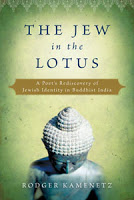Jesse Kellerman (commentary.org., Jan. 2020); Sociologist Dr. Emily Sigalow, Ph.D. (emilysigalow.com); Sheldon S., Dhr. Seven, Amber Larson (eds.), Wisdom Quarterly
.jpeg) |
| Yes, it's here in the Book of Revelation! He's not blond. He's bronze with a wooly afro. |
 |
| Buddhism is far fairer to females. |
In American JewBu: Jews, Buddhists, and Religious Change, her examination of the American Jewish-Buddhist encounter, sociologist Dr. Emily Sigalow cites anecdotal evidence suggesting that Jews constitute up to 30 percent of Western Buddhists in the United States, far out of proportion to their number in the general population.
 |
| American JewBu (Princeton) |
American Jews’ particular fondness for Buddhism is difficult to account for. Among the theories Dr. Sigalow reviews and rejects are religious or cultural overlaps, such as
- “a shared focus on suffering” or an emphasis on text study;
- Jewish overrepresentation in “the segments of society to which Buddhism appeals most strongly:
- the highly educated upper middle class,
- intellectuals,
- artists, and
- bohemians”;
- an innate attraction toward the “body-based practice” of meditation;
- identification with “the Buddhist approach to the elimination of
- war,
- poverty,
- racism,
- prejudice,
- environmental pollution,
- intemperance, and
- drug abuse.”
 |
| The JuBu Q was asked before |
To Dr. Sigalow, each of these explanations is incomplete. Other systems offer body-based practices: ecstatic dance, capoeira (Brazilian martial art), Rolfing.
If Jews and Buddhists share that much common ground, why have so many Jews become Buddhists while so few Buddhists have become Jews?
Ultimately, Dr. Sigalow sees fit to “repudiate any claim of an intrinsic affinity between these traditions,” locating the point of contact between the two in “the historical and social webs that connect them.”
The original JewBu
 |
| Jewish Jesus became a Buddhist monk (BBC) |
- {According to written scrolls, Jewish-Buddhist Jesus [the future Maitreya or messiah] abandoned Jerusalem at the age of 13 and set out towards Sindh/Gandhara, “intending to improve and perfect himself in the divine understanding and to studying the laws of the great Buddha.” He crossed Punjab and reached Puri Jagannath where he studied the Vedas under Brahmin priests. He spent six years in Puri and Rajgir, near Nalanda, the ancient seat of Buddhist learning (history's first university apart from Timbuktu and Gandhara's Taxila, where the Bodhisattva and Ananda attended college in a past life]. Then he went to the Himalayas, and spent time in Tibetan Buddhist monasteries, studying Buddhism [30], and through Persia (the Aryan Land of proto-Iran), returned to Jerusalem at the age of 29. More}
 |
| I did samadhi and siddhis. |
Gamely she draws a historical throughline, but it’s evident that Strauss and Goldwater are notable primarily as outliers. What’s true for the Jews holds for American Buddhism more generally:
Only in the latter half of the 20th century does it truly begin to assume its current shape. Here, in the liberalization of the postwar era, we come to the Zen of the Beats and the rise of the counterculture, currents fairly swimming with Jews.
We witness the absorption of a specific ritual practice, vipassana (insight) meditation, into the standard psychological armamentarium in the form of Mindfulness-Based Stress Reduction (MBSR), or more simply, “mindfulness.”
More than any other aspect of Buddhism, it is meditation that has taken root in our national consciousness.
A 2018 Pew survey found, somewhat dubiously, that 40 percent of Americans claim to meditate at least once a week. The popularity of MBSR no doubt arises in large part from its uniquely American character:
- freed of metaphysical encumbrances such as rebirth and repackaged as a utilitarian commodity that promises to ease burdens, heighten concentration, and enhance overall happiness.
One might further compare the difference between traditional Buddhism and its most highly digested variants to that between aged cheddar and Kraft singles.
And, as with the counterculture, American Jews such as Jack Kornfield, [Joseph Goldstein, Sharon Salzberg], Sylvia Boorstein, and Jon Kabat-Zinn have been foremost among the homogenizers. More
- Jewish Voice for Peace (jvp.org)
- Race and appearance of [Jewish] Jesus
- Rodger Kamenetz author of The Jew in the Lotus: A Poet's Rediscovery of Jewish Identity in Buddhist India (BIO)
- LSD and the Rabbis: Conclusion | Center for Jewish Studies (duke.edu)
- Bhikkhu Bodhi (Jeffrey Block)
- Sylvia Boorstein
- Tara Brach
- Thubten Chodron
- Leonard Cohen (former Zen monk)
- Peter Coyote
- Surya Das
- Ram Dass (Richard Alpert)
- Robert Downey Jr.
- Mark Epstein
- Anthony Ervin
- Zoketsu Norman Fischer
- Allen Ginsberg
- Philip Glass
- Tetsugen Bernie Glassman
- Craig Taro Gold
- Natalie Goldberg
- Yuval Noah Harari
- Joseph Goldstein
- Julius Goldwater
- Daniel Goleman
- Dan Harris
- Goldie Hawn
- Jon Kabat-Zinn
- Ayya Khema
- Jack Kornfield
- Noah Levine
- Stephen Levine
- Jay Michaelson
- Ethan Nichtern
- Ven. Nyanatiloka (Anton Gueth)
- Mandy Patinkin
- Jeremy Piven
- Linda Pritzker
- Nick Ribush
- Jonathan F.P. Rose
- Larry Rosenberg
- Sharon Salzberg
- Steven Seagal
- Helen Tworkov
- Adam Yauch (Beastie Boy)
- Shinzen Young
- List of converts to Buddhism (Wiki)





















































































































































































































































No comments:
Post a Comment